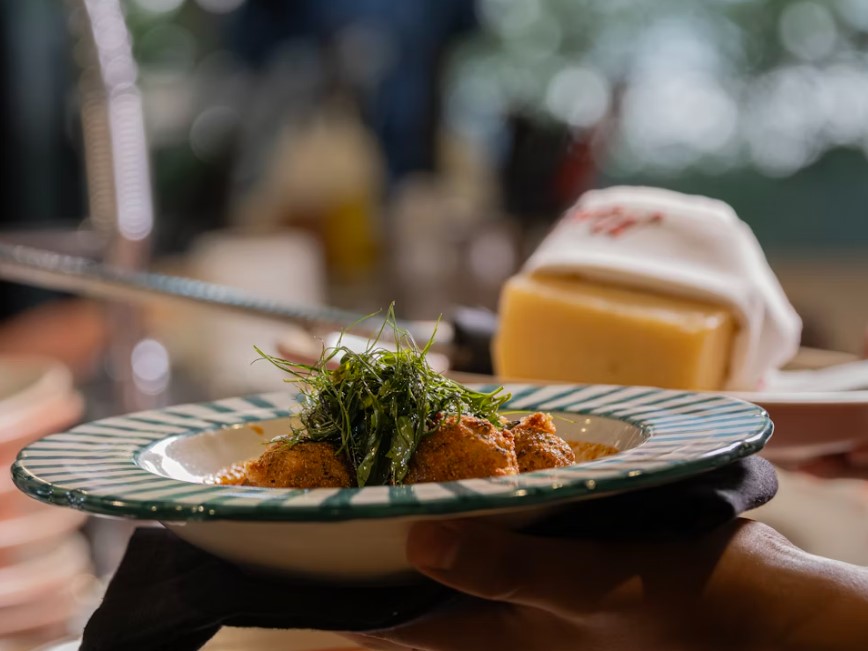Levapioli is more than just a meal; it’s a celebration of Italy’s rich culinary tradition, passed down through generations and flavored by the distinctive tastes of each region. From the rolling hills of Tuscany to the sun-drenched coastal cities of the south, Levapioli has become a beloved dish that captures the heart and soul of Italian cuisine. With a history rooted in simplicity and savory flavors, this dish continues to evolve, finding its place not only on Italian tables but also in kitchens around the world.
In this article, we’ll explore Levapioli’s fascinating origins, traditional recipes, regional variations across Italy, and global adaptations that showcase its versatility. Whether you’re an aspiring home cook or a seasoned chef, prepare to embark on a culinary journey that brings Italy’s diverse flavors to your plate.
What is Levapioli?
Levapioli, often referred to as a type of Italian meatball or sausage, is a traditional dish made primarily from minced meat, which is typically a mixture of beef and lamb. The ingredients are simple: salt, pepper, garlic, and sometimes other spices or herbs, depending on the region. Once mixed, the meat is shaped into small sausages or patties and either grilled over an open flame or fried in olive oil, resulting in a crispy, flavorful exterior and juicy interior.
Levapioli’s charm lies in its simplicity—every ingredient plays a key role in bringing out the natural flavors of the meat. However, the true magic happens when regional influences come into play, making each variation of Levapioli distinct. Over time, this dish has evolved, with different parts of Italy adding their unique twists based on local ingredients and culinary traditions.
Traditional Levapioli Recipe and Cooking Methods
The Base Recipe: A Simple, Yet Flavorful Delight
To prepare a traditional Levapioli, you’ll need the following ingredients:
- 500g of minced beef
- 500g of minced lamb (or a combination of both)
- 2 cloves of garlic, minced
- Salt and pepper to taste
- Fresh herbs such as parsley, rosemary, or thyme (optional)
Method:
- Prepare the Meat: In a large bowl, mix the minced beef and lamb. Add the garlic, salt, and pepper, along with any optional herbs.
- Shape the Mixture: Using your hands, shape the meat into small sausages or patties, ensuring they are evenly sized for consistent cooking.
- Cook the Levapioli: Traditionally, Levapioli is grilled over an open flame, which gives it a smoky flavor. If you don’t have access to a grill, frying them in olive oil is a suitable alternative. Cook the Levapioli for about 5-7 minutes on each side or until golden brown and cooked through.
- Serve: Levapioli is typically served on fresh bread or alongside roasted vegetables. A drizzle of homemade chutney or a side of grilled peppers can elevate the flavors further.
Alternative Cooking Methods
While grilling over an open flame is the most traditional cooking method, Levapioli can also be baked in the oven. Simply place the shaped meat on a baking tray and bake at 180°C (350°F) for about 20-25 minutes or until browned and cooked through.
Regional Variations of Levapioli in Italy
Italy’s diverse geography and culture have led to numerous regional variations of Levapioli. From the rich, creamy recipes of the north to the bold, spicy flavors of the south, each region has added its personal touch to this classic dish.
Northern Italy: Rich, Creamy, and Herb-Infused
In Northern Italy, Levapioli often incorporates local cheeses such as Parmigiano-Reggiano or Gorgonzola, adding a creamy richness to the dish. Chefs in this region might also use a blend of beef and pork for a fuller, richer flavor. The use of wild herbs like rosemary and thyme enhances the complexity of the dish, while some recipes even incorporate milk to create a smooth texture.
The cooking methods in the north may vary, with some opting for baking in the oven rather than grilling, ensuring the Levapioli remains tender. This variation showcases Northern Italy’s affinity for richer, creamier flavors.
Central Italy: Simple and Fresh
In Central Italy, Levapioli is often prepared with a minimalist approach. Tuscan recipes, for example, use fresh, local herbs such as rosemary and sage, with garlic and salt as the primary seasonings. This simple approach highlights the quality of the meat itself, allowing its natural flavors to shine.
In Rome, Levapioli is sometimes spiced up with red pepper flakes, while in Umbria, wild mushrooms or truffles are often incorporated for a gourmet touch. These ingredients reflect Central Italy’s agricultural roots and rustic culinary traditions.
Southern Italy: Bold, Spicy, and Flavorful
Southern Italy’s Levapioli is a celebration of bold, vibrant flavors. Commonly made with a mix of lamb and pork, the meat is seasoned with local herbs like oregano and basil. The southern variations often include a touch of heat, such as chili flakes or garlic, to reflect the region’s love for bold, spicy food.
In Sicily, you might find Levapioli infused with citrus flavors, such as a hint of orange zest. Additionally, the dish may be served with traditional side dishes like caponata, a sweet-sour eggplant stew that perfectly complements the savory meat.
Levapioli in Coastal Areas
In the coastal regions of Southern Italy, seafood often plays a role in Levapioli. This variation might feature seafood flavors mixed into the meat blend or Levapioli served with a seafood-based sauce or side, creating a fresh and vibrant combination of flavors.
Global Adaptations of Levapioli
Levapioli’s delicious blend of flavors and simplicity have made it a popular dish far beyond Italy. As the dish spreads worldwide, different cultures and culinary traditions have put their own spin on this classic.
Levapioli in the United States
In the United States, Levapioli has become a popular choice at food trucks and street food festivals. Many American versions feature bold spices like paprika or barbecue sauce, and sometimes the meat blend is altered to cater to local tastes, such as using turkey or chicken instead of beef and lamb.
The American Levapioli is often served in creative ways, such as on buns with toppings like jalapeños, chipotle mayo, or even kimchi. This modern twist on the dish captures the multicultural influences found in American cuisine.
Levapioli in Canada
Chefs in Canada have experimented with Levapioli by incorporating local ingredients like maple syrup into marinades. This sweet touch adds a unique contrast to the savory meat and reflects Canada’s distinctive culinary identity.
Levapioli in Brazil
In Brazil, Levapioli is often made with picanha seasoning, a rich blend of herbs and spices traditionally used for Brazilian barbecues. This version of Levapioli has a deep, smoky flavor and is often served with accompaniments like farofa (toasted cassava flour) for added texture.
Levapioli in Australia
Australia’s multicultural influences are evident in the country’s take on Levapioli, with some chefs adding ingredients like ginger, soy sauce, or other Asian-inspired seasonings to the meat blend. These adaptations reflect Australia’s diverse culinary influences while still staying true to the essence of Levapioli.
Unique Ingredients in Levapioli
While the core of Levapioli remains consistent, regional and global variations often incorporate unique ingredients to elevate the dish. Some of the most popular ingredients used in Levapioli include:
- Cheeses: Parmigiano-Reggiano, Gorgonzola, and Fontina cheese add richness and depth to the dish.
- Herbs: Fresh herbs like rosemary, sage, thyme, and parsley enhance the flavor profile of Levapioli, making it aromatic and flavorful.
- Spices: Ingredients such as chili flakes, garlic, and paprika add warmth and spice, especially in Southern Italy and beyond.
- Citrus: A touch of lemon or orange zest is common in Sicilian variations, brightening up the savory flavor of the meat.
- Maple Syrup: Used in Canadian versions of Levapioli, maple syrup adds a unique sweet note that contrasts with the savory meat.
- Picanha Seasoning: Found in Brazilian adaptations, this seasoning blend offers a smoky, deep flavor.
Conclusion: Levapioli—A Global Culinary Treasure
Levapioli represents the heart and soul of Italian cuisine. With its simplicity, rich history, and regional variations, this dish has evolved into a global culinary treasure, beloved by food enthusiasts around the world. From the creamy, herb-infused versions of Northern Italy to the bold, spicy flavors of the south, Levapioli offers something for everyone.
Whether you’re enjoying a traditional Italian recipe or experimenting with a global twist, Levapioli remains a timeless dish that brings people together, sparking conversations around the table and providing a true taste of Italy’s diverse culinary landscape.
FAQs
What is Levapioli made from?
Levapioli is made from minced beef and lamb, seasoned with garlic, salt, pepper, and sometimes herbs or spices.
How is Levapioli cooked?
Levapioli is traditionally grilled over an open flame for a smoky flavor, but it can also be fried in olive oil or baked in the oven.
What are some regional variations of Levapioli?
Levapioli varies across Italy. Northern Italy often includes cheeses and herbs, while Southern Italy adds spicy ingredients like chili flakes. Central Italy focuses on simplicity with fresh herbs and garlic.
Can Levapioli be adapted for other cuisines?
Yes, Levapioli has inspired various adaptations worldwide, including in the United States, Brazil, and Australia, where local spices and ingredients are incorporated.
For More Updates Visit: Biomagazine








Leave a Reply